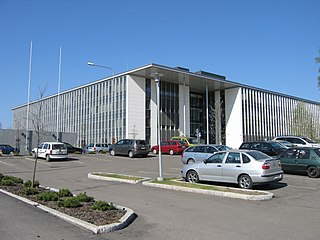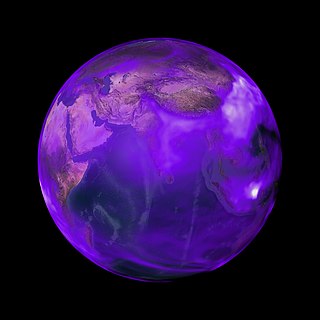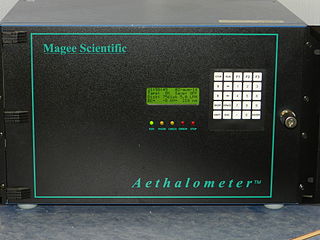Related Research Articles

Smoke is a suspension of airborne particulates and gases emitted when a material undergoes combustion or pyrolysis, together with the quantity of air that is entrained or otherwise mixed into the mass. It is commonly an unwanted by-product of fires, but may also be used for pest control (fumigation), communication, defensive and offensive capabilities in the military, cooking, or smoking. It is used in rituals where incense, sage, or resin is burned to produce a smell for spiritual or magical purposes. It can also be a flavoring agent and preservative.

Environmental engineering is a professional engineering discipline that encompasses broad scientific topics like chemistry, biology, ecology, geology, hydraulics, hydrology, microbiology, and mathematics to create solutions that will protect and also improve the health of living organisms and improve the quality of the environment. Environmental engineering is a sub-discipline of civil engineering and chemical engineering. While on the part of civil engineering, the Environmental Engineering is focused mainly on Sanitary Engineering.

Environmental science is an interdisciplinary academic field that integrates physics, biology, and geography to the study of the environment, and the solution of environmental problems. Environmental science emerged from the fields of natural history and medicine during the Enlightenment. Today it provides an integrated, quantitative, and interdisciplinary approach to the study of environmental systems.

A polycyclic aromatic hydrocarbon (PAH) is a class of organic compounds that is composed of multiple aromatic rings. The simplest representative is naphthalene, having two aromatic rings and the three-ring compounds anthracene and phenanthrene. PAHs are uncharged, non-polar and planar. Many are colorless. Many of them are found in coal and in oil deposits, and are also produced by the combustion of organic matter—for example, in engines and incinerators or when biomass burns in forest fires.

The Finnish Meteorological Institute is the government agency responsible for gathering and reporting weather data and forecasts in Finland. It is a part of the Ministry of Transport and Communications but it operates semi-autonomously.

Atmospheric dispersion modeling is the mathematical simulation of how air pollutants disperse in the ambient atmosphere. It is performed with computer programs that include algorithms to solve the mathematical equations that govern the pollutant dispersion. The dispersion models are used to estimate the downwind ambient concentration of air pollutants or toxins emitted from sources such as industrial plants, vehicular traffic or accidental chemical releases. They can also be used to predict future concentrations under specific scenarios. Therefore, they are the dominant type of model used in air quality policy making. They are most useful for pollutants that are dispersed over large distances and that may react in the atmosphere. For pollutants that have a very high spatio-temporal variability and for epidemiological studies statistical land-use regression models are also used.

An urban canyon is a place where the street is flanked by buildings on both sides creating a canyon-like environment, evolved etymologically from the Canyon of Heroes in Manhattan. Such human-built canyons are made when streets separate dense blocks of structures, especially skyscrapers. Other examples include the Magnificent Mile in Chicago, Los Angeles' Wilshire Boulevard corridor, Toronto's Financial District, and Hong Kong's Kowloon and Central districts.

Chemically, black carbon (BC) is a component of fine particulate matter. Black carbon consists of pure carbon in several linked forms. It is formed through the incomplete combustion of fossil fuels, biofuel, and biomass, and is one of the main types of particle in both anthropogenic and naturally occurring soot. Black carbon causes human morbidity and premature mortality. Because of these human health impacts, many countries have worked to reduce their emissions, making it an easy pollutant to abate in anthropogenic sources.

Transportation forecasting is the attempt of estimating the number of vehicles or people that will use a specific transportation facility in the future. For instance, a forecast may estimate the number of vehicles on a planned road or bridge, the ridership on a railway line, the number of passengers visiting an airport, or the number of ships calling on a seaport. Traffic forecasting begins with the collection of data on current traffic. This traffic data is combined with other known data, such as population, employment, trip rates, travel costs, etc., to develop a traffic demand model for the current situation. Feeding it with predicted data for population, employment, etc. results in estimates of future traffic, typically estimated for each segment of the transportation infrastructure in question, e.g., for each roadway segment or railway station. The current technologies facilitate the access to dynamic data, big data, etc., providing the opportunity to develop new algorithms to improve greatly the predictability and accuracy of the current estimations.
In environmental science, air pollution dispersion is the distribution of air pollution into the atmosphere. Air pollution is the introduction of particulates, biological molecules, or other harmful materials into Earth's atmosphere, causing disease, death to humans, damage to other living organisms such as food crops, and the natural or built environment. Air pollution may come from anthropogenic or natural sources. Dispersion refers to what happens to the pollution during and after its introduction; understanding this may help in identifying and controlling it.

Air pollution is the contamination of air due to the presence of substances in the atmosphere that are harmful to the health of humans and other living beings, or cause damage to the climate or to materials. It is also the contamination of indoor or outdoor surrounding either by chemical activities, physical or biological agents that alters the natural features of the atmosphere. There are many different types of air pollutants, such as gases, particulates, and biological molecules. Air pollution can cause diseases, allergies, and even death to humans; it can also cause harm to other living organisms such as animals and food crops, and may damage the natural environment or built environment. Air pollution can be caused by both human activities and natural phenomena.

Active mobility, soft mobility, active travel, active transport or active transportation is the transport of people or goods, through non-motorized means, based around human physical activity. The best-known forms of active mobility are walking and cycling, though other modes include running, rowing, skateboarding, kick scooters and roller skates. Due to its prevalence, cycling is sometimes considered separately from the other forms of active mobility.
The Operational Street Pollution Model (OSPM) is an atmospheric dispersion model for simulating the dispersion of air pollutants in so-called street canyons. It was developed by the National Environmental Research Institute of Denmark, Department of Atmospheric Environment, Aarhus University. As a result of reorganisation at Aarhus University the model has been maintained by the Department of Environmental Science at Aarhus University since 2011. For about 20 years, OSPM has been used in many countries for studying traffic pollution, performing analyses of field campaign measurements, studying efficiency of pollution abatement strategies, carrying out exposure assessments and as reference in comparisons to other models. OSPM is generally considered as state-of-the-art in practical street pollution modelling.
CTAG is a computational fluid dynamics model for the behaviour of air pollutants on and near roadways.

An aethalometer is an instrument for measuring the concentration of optically absorbing (‘black’) suspended particulates in a gas colloid stream; commonly visualized as smoke or haze, often seen in ambient air under polluted conditions. The word aethalometer is derived from the Classical Greek verb aethaloun, meaning "to blacken with soot".
The Hybrid Single-Particle Lagrangian Integrated Trajectory model (HYSPLIT) is a computer model that is used to compute air parcel trajectories to determine how far and in what direction a parcel of air, and subsequently air pollutants, will travel. HYSPLIT is also capable of calculating air pollutant dispersion, chemical transformation, and deposition. The HYSPLIT model was developed by the National Oceanic and Atmospheric Administration (NOAA) Air Resources Laboratory and the Australian Bureau of Meteorology Research Centere in 1998. The model derives its name from the usage of both Lagrangian and Eulerian approaches.
Nicolas Moussiopoulos is a Greek engineer and university professor at the Aristotle University of Thessaloniki. His research interests are in the field of Environmental Engineering.

Michael Bruse is a German geographer and professor for geoinformatics at Johannes Gutenberg University Mainz. He specializes in research on urban microclimate/climatology with a methodical focus on numerical simulation. Besides his scientific work he developed the micro-climate model ENVI-met. and is founder of the company ENVI-met GmbH. ENVI-met is a holistic three-dimensional non-hydrostatic model for the simulation of surface-plant-air interactions not only limited to, but very often used to simulate urban environments and to assess the effects of green architecture visions.
A land use regression model is an algorithm often used for analyzing pollution, particularly in densely populated areas.
References
- ↑ Elsevier publishers, Atmospheric Environment website
- ↑ A. Dobre; S.J. Arnold; R.J. Smalley; J.W.D. Boddy; J.F. Barlow; A.S. Tomlin; S.E. Belcher (August 2005). "Flow field measurements in the proximity of an urban intersection in London, UK". Atmospheric Environment. 39 (26): 4647–4657. Bibcode:2005AtmEn..39.4647D. doi:10.1016/j.atmosenv.2005.04.015.
- ↑ "Taking A Taxi Could Increase Your Exposure To Pollution", Science Daily, January 11, 2006